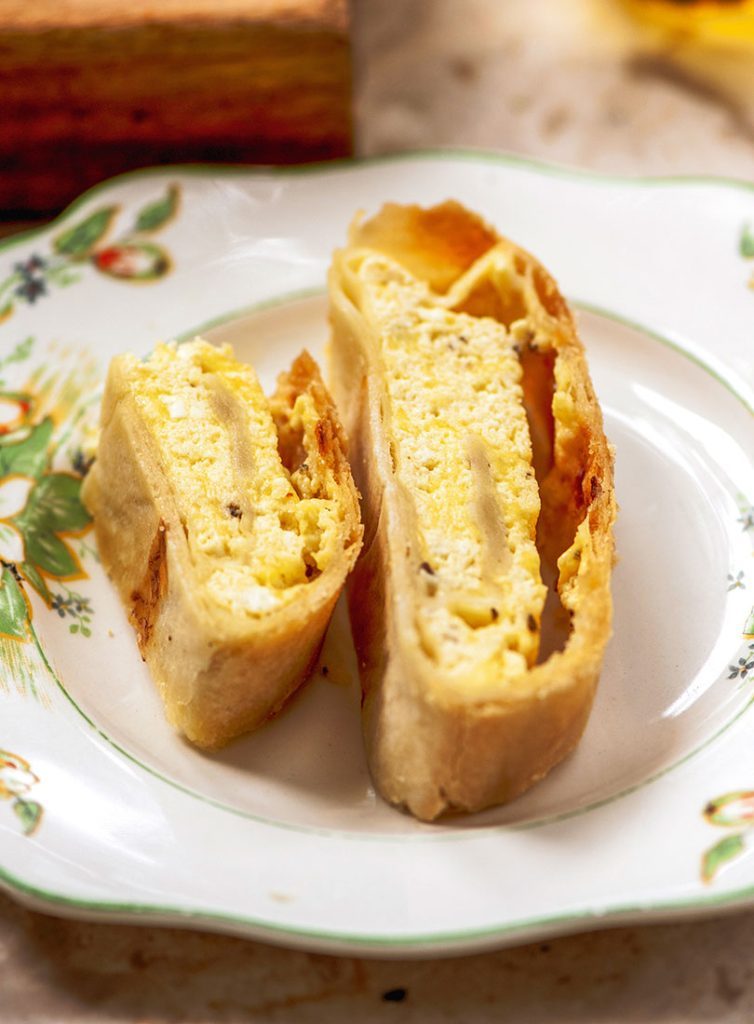Spiced Cheese Strudel (Strudel Di Formaggi)
Paola Bacchia

Serves
8Ingredients
| FOR THE PASTRY | |
| 180g (1¼ cups) plain (all-purpose) flour, plus extra for dusting | |
| sea salt | |
| 2½ tablespoons extra virgin olive oil | |
| FOR THE FILLING | |
| 400g ricotta, well drained | |
| 50ml pouring (single/light) cream | |
| 50g Greek-style yoghurt | |
| 50g (½ cup) grated parmesan | |
| 125g cumin-spiced gouda, grated (or use regular gouda and add ½ teaspoon toasted cumin seeds) | |
| 50g unsalted butter, at room temperature | |
| 2 eggs, separated | |
| 2 teaspoons French mustard | |
| sea salt and freshly cracked black pepper | |
| TO FINISH | |
| milk, for brushing | |
| grated parmesan, for sprinkling |
The filling of this savoury cheese strudel is inspired by one in Francesco Gottardi’s book about the food of Fiume/Rijeka during the reign of the Hapsburgs.
View the recipe collection here
Instructions
| 1. | To make the pastry, place the flour in a bowl with a pinch of salt, giving it a good whisk to combine. |
| 2. | Make a well in the centre, add the olive oil and 105ml of water and stir with a spoon until well combined. |
| 3. | Tip the pastry onto a floured work surface and knead initially with your fingertips, until it no longer sticks to your fingers, and then with the heel of your hand for at least 10 minutes. |
| 4. | Don’t be tempted to add extra flour – the dough will end up very smooth, soft and supple. |
| 5. | Place in a clean bowl, cover with an upturned plate and leave to rest for 30 minutes. |
| 6. | To make the filling, place the ricotta in a large bowl and mix with a spoon to smooth out any lumps. |
| 7. | Add the cream, yoghurt, parmesan, gouda, butter, egg yolks and mustard. |
| 8. | Season with salt and pepper and mix until well combined. The mixture will be quite thick. |
| 9. | Beat the egg whites with a whisk until medium peaks form, then fold through the cheese mixture in batches. Set aside until ready to use. |
| 10. | Preheat the oven to 160°C (320°F) fan-forced. |
| 11. | Place a clean tablecloth on a flat surface and dust with flour, ready for rolling the dough. |
| 12. | To roll out the pastry dough, dust your work surface with extra flour and gently roll the dough into a rectangle, flipping it over regularly and dusting with more flour as you go, so the delicate pastry does not stick and tear. |
| 13. | Once the dough is about 30cm x 40cm, carefully lift it onto the floured tablecloth. |
| 14. | Finish stretching the dough by hand, by carefully placing your hands under the pastry sheet and gently stretching any sections that look thicker. Your sheet needs to be at least 50cm x 60cm. |
| 15. | If it is any smaller than this, you haven’t stretched it thinly enough – you should be able to easily read through the dough. |
| 16. | When you are ready to assemble the strudel, turn the dough so a shorter edge is facing you. Trim any thick edges and discard. |
| 17. | Spoon the filling over the bottom one-third of the dough. |
| 18. | Using the tablecloth to assist you, gently roll the strudel into a long sausage. |
| 19. | I kept the strudel straight, but for this you will need a long baking tray and a large enough oven. |
| 20. | Alternatively, you can curve the strudel into a horse-shoe shape and lift it onto a lined baking tray. |
| 21. | Bake for 25 minutes, then brush the strudel with milk. |
| 22. | Check the pastry isn’t browning too quickly; if it is, reduce the oven temperature slightly. |
| 23. | Continue baking for another 20 minutes. |
| 24. | Scatter some parmesan over the strudel and bake for another 5 minutes, or until the cheese has melted and is golden, and the pastry is cooked. |
| 25. | Allow to cool slightly before slicing; the strudel is delicious warm or at room temperature. |
| 26. | Once cooled, the strudel can be stored in an airtight container in the fridge for a few days. |
 This is an edited
This is an edited
extract from Istria
by Paola Bacchia,
published by Smith
St Books, $65.
Photographs by
Paola Bacchia.
